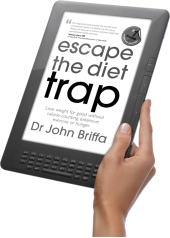While I am an enthusiastic advocate of exercise, I am sometimes keen to dispel the idea that it helps the ‘pounds drop off’. Actually, the bulk of the evidence does not support exercise as a particularly effective tool for weight loss. Somehow, I think people are wising up to this now. For instance, I’ve had two conversations this week with individuals about the relative importance of diet and exercise in weight loss. Neither of them have a special interest in the area, but both of them spontaneously expressed the opinion that its ‘80 per cent diet’.
There are actually a few plausible mechanisms that may help to explain why exercise generally induces only modest weight losses, if any at all. One is that, generally speaking, exercise does not burn calories at a phenomenal rate. A run of 45 minutes may burn 350 calories over and above those that would be burned otherwise, but there’s about 3,500 calories in a pound of fat. So, theoretically, someone would have to get through ten, 45-minute runs to lose a pound of fat.
Of course, things are not always this simple. One reason concerns the fact that when people exercise more, they may eat more too. This could be because they’re hungrier, though sometimes it’s perhaps related to someone ‘rewarding’ themselves, or just feeling they can get away with some more calories because of the exercise they took earlier.
The heightened hunger that can come as a result of exercise does not happen to everyone, but my experience tells me it tends to be more common in individuals who engage in relatively prolonged exercise such as extended running or cycling. In my book Escape the Diet Trap I made the observation that ‘high intensity intermittent exercise’ (short, intense bursts of activity interspersed with longer periods of rest) tended not to make people hungrier.
Now, recently, a study was published which lends at least some support to these observations.
In this research, overweight, sedentary men were (at different times) subjected each of the following conditions:
1. continuous exercise at 60 per cent of maximum oxygen utilisation (VO2 max) for 30 minutes
2. 1 minute at 100 per cent VO2 max alternating with 4 minutes of 50 per cent VO2 max, repeated for a total exercise time of 30 minutes
3. 15 seconds of exercise at 170 per cent VO2 max alternating with 60 seconds at 32 per cent VO2 max for a total of 30 minutes
4. Rest (no exercise) for 30 minutes
After each condition, the men were fed a meal with a set number of calories. 70 minutes later, they were given access to food that they could eat freely. Food intake and activity levels were monitored on the day of each experiment and the following day (a total of 38 hours).
Interestingly, the intakes of the test meal 70 minutes after conditions 2 and 3 were lower than that when no exercise was taken (condition 4).
Also, energy intake over 38 was lower after condition 3 than after conditions 1 and 4.
Interestingly, I think, after condition 4, levels of the appetite-stimulating hormone ghrelin were lower, and blood sugar levels higher, than after the other conditions. Levels of lactate were also higher, and there is some evidence that lactate suppresses appetite [2].
This study was short, in that each condition was only tested once. However, there is at least some evidence here to support the idea that high-intensity exercise not only may not stimulate the appetite, but might even suppress it.
References:
1. Sim AY, et al. High-intensity intermittent exercise attenuates ad-libitum energy intake. International Journal of Obesity. advance online publication 9 July 2013
2. Schultes B, et al. Lactate infusion during euglycemia but not hypoglycemia reduces subsequent food intake in healthy men. Appetite 2012;58(3):818–821[hr]
[box style=”rounded” border=”full”]
Dr John Briffa’s best-selling ESCAPE THE DIET TRAP – lose weight without calorie-counting, extensive exercise or hunger is available in the UK and US
“This magnificent book provides the scientific basis and practical solutions to liberate you from yo-yo dieting and allow you to achieve sustained weight loss and enhanced health with ease.”
William Davis MD – #1 New York Times bestselling author of Wheat Belly
To read some of the dozens of 5-star reviews for this book [button link=”http://www.drbriffa.com/amazon-reviews-for-escape-the-diet-trap/” color=”silver” text=”dark” window=”yes”]click here[/button]
To buy a paperback copy of the book from amazon.co.uk [button link=”http://www.amazon.co.uk/Escape-Diet-Trap-John-Briffa/dp/0007447760/ref=tmm_pap_title_0?ie=UTF8&qid=1324815918&sr=1-1″ color=”orange” window=”yes”]click here[/button]
To buy a kindle version of the book from amazon.co.uk [button link=”http://www.amazon.co.uk/Escape-the-Diet-Trap-ebook/dp/B005ODY0RW/ref=tmm_kin_title_0?ie=UTF8&qid=1324815918&sr=1-1″ color=”orange” window=”yes”]click here[/button]

To buy a print copy of the book from amazon.com [button link=”http://www.amazon.com/Escape-Diet-Trap-calorie-counting-extensive/dp/0957581602/” color=”orange” window=”yes”]click here[/button]

To buy the kindle version of the book from amazon.com [button link=”http://www.amazon.com/dp/B00BLQ40QM” color=”orange” window=”yes”]click here[/button]
[/box]